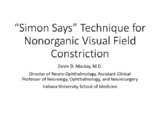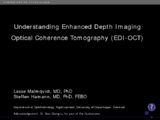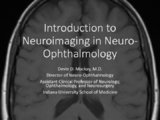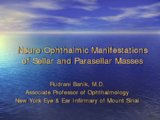Collection of materials relating to neuro-ophthalmology as part of the Neuro-Ophthalmology Virtual Education Library.
NOVEL: https://novel.utah.edu/
TO
- NOVEL728
| Title | Creator | Description | Subject | ||
|---|---|---|---|---|---|
| 126 |
 |
Confrontation Visual Fields - A Concise Guide for Ophthalmology and Neurology Trainees | Stephen C. Pollock, MD | The guide describes the techniques required to competently perform confrontation visual fields. It outlines a basic screening protocol and discusses methods for further defining defects identified during the screening process. A mini-atlas of visual field defects is included as an appendix. | Confrontation Visual Fields; Visual Field Testing; Perimetry; Visual Field Loss; Visual Field Defect; Ocular Examination; Visual Sensory Evaluation; Neurologic Examination |
| 127 |
 |
Dual Visual Field Defect (Quadrantanopia and Central Scotoma) Unmasks the Hidden Brain Lesion in a Patient with Non-arteritic Ischemic Optic Neuropathy | A. Mohan Kannam; B. Rajat Kapoor; C. Ramesh Kekunnaya, FRCS; Virender Sachdeva, MS, DNB | This submission is an interesting case that highlights the co-existence of two different visual field defects in the same patient presenting to us with clinical picture of non arteritic ischemic optic neuropathy. The correct interpretation of the visual field defects led to the appropriate localizat... | Hemianopia; Central Field Defect; Non-Arteritic Ischemic Optic Neuropathy; Ischemic Infarct |
| 128 |
 |
Clinical Visual Electrophysiology | Gregory P. Van Stavern, MD; Byron Lam, MD | A description of the use of electrophysiology to examine the visual system. | Electrophysiology; Visual Exam |
| 129 |
 |
Fundus Fluorescein Angiography: What Is It and When Is It Useful for Neuro-Ophthalmology? | Clare L. Fraser, MBBS; Elisa E. Cornish, PhD | An introduction to the use of fluorescein angiography. | Fluorescein Angiography; Visual Exam |
| 130 |
 |
Hirschberg Test Corneal Reflex Test | Nagham Al-Zubidi, MD | Description of the Hirschberg test a the corneal reflex test. | Hirschberg Test; Corneal Reflex |
| 131 |
 |
Testing Eye Movements | Marc Dinkin, MD | Description of eye movement testing. | Eye Movements; Exams |
| 132 |
 |
The Mental Status Examination - Non-Cognitive | James R. Bateman, MD, MPH; Victoria S. Pelak, MD | Introduction to the mental status examination. | Mental Status; Non-Cognitive Function |
| 133 |
 |
The Mental Status Examination - Cognitive | James R. Bateman, MD, MPH; Victoria S. Pelak, MD | Introduction to the cognitive mental status examination. See accompanying videos: Executive function: https://collections.lib.utah.edu/ark:/87278/s6bw1rp1, Limb-Kinetic apraxia: https://collections.lib.utah.edu/ark:/87278/s63c084b, Ideomotor apraxia: https://collections.lib.utah.edu/ark:/87278/s674... | Mental Status; Cognitive Function |
| 134 |
 |
The Clinical Examination of Higher Order Visual Function: Syndrome-based Approach - Visual Neglect | Victoria S. Pelak, MD; James R. Bateman, MD, MPH; Brianne Bettcher, PhD | Explanation of higher order visual function examination. See accompanying video, Double simultaneous visual field stimulation: https://collections.lib.utah.edu/ark:/87278/s6gn2h9d | Visual Function; Visual Neglect |
| 135 |
 |
"Simon Says" Technique for Nonorganic Visual Field Constriction | Devin D. Mackay, MD | Explanation of the "Simon says" technique. | Simon Says, Visual Field Constriction |
| 136 |
 |
The Clinical Examination of Higher Order Visual Function: Syndrome-based Approach - Visual Simultanagnosia | Victoria S. Pelak, MD; James R. Bateman, MD, MPH; Brianne Bettcher, PhD | Explanation of higher order visual function examination. | Visual Function; Visual Simultanagnosia |
| 137 |
 |
The Clinical Examination of Higher Order Visual Function: Syndrome-based Approach - Visual Prosopagnosia | Victoria S. Pelak, MD; James R. Bateman, MD, MPH; Brianne Bettcher, PhD | Explanation of higher order visual function examination. | Visual Function; Visual Prosopagnosia |
| 138 |
 |
The Clinical Examination of Higher Order Visual Function: Syndrome-based Approach - Visual Central Achromatopsia | Victoria S. Pelak, MD; James R. Bateman, MD, MPH; Brianne Bettcher, PhD | Explanation of higher order visual function examination. | Visual Function; Visual Central Achromatopsia |
| 139 |
 |
The Clinical Examination of Higher Order Visual Function: Syndrome-based Approach - Visual Constructional Apraxia | Victoria S. Pelak, MD; James R. Bateman, MD, MPH; Brianne Bettcher, PhD | Explanation of higher order visual function examination. | Visual Function; Visual Constructional Apraxia |
| 140 |
 |
Neuropsychological Assessment | Brianne M. Bettcher, PhD; James R. Bateman, MD, MPH; Victoria S. Pelak, MD | Introduction to neuropsychology and neuropsychological assessments. | Neuropsychological Assessment |
| 141 |
 |
Understanding Enhanced Depth Imaging Optical Coherence Tomography (EDI-OCT) | Lasse Malmqvist, MD, PhD; Steffen Hamann, MD, PhD, FEBO | This is an explanation of using the enhanced depth imaging optical coherence tomography technique for examination. | Enhanced Depth Imaging |
| 142 |
 |
The Ocular Examination of the Comatose Patient | John Pula, MD | Description of conducting an ocular examination of a comatose patient. | Examination; Coma |
| 143 |
 |
The Mental Status Examination | James R. Bateman, MD, MPH; Victoria S. Pelak, MD | Introduction to the mental status examination. See accompanying videos: Executive function: https://collections.lib.utah.edu/ark:/87278/s6bw1rp1, Limb-Kinetic apraxia: https://collections.lib.utah.edu/ark:/87278/s63c084b, Ideomotor apraxia: https://collections.lib.utah.edu/ark:/87278/s67410xj | Mental Status |
| 144 |
 |
The Clinical Examination of Higher Order Visual Function: Syndrome-Based Approach | Victoria S. Pelak, MD; James R. Bateman, MD, MPH; Brianne Bettcher, PhD | Explanation of higher order visual function examination. See accompanying video, Double simultaneous visual field stimulation: https://collections.lib.utah.edu/ark:/87278/s6gn2h9d | Visual Function |
| 145 |
 |
Using Pupillometry in Clinical Medicine | Aki Kawasaki, MD | Description of the use of pupillometry in clinical medicine. | Pupillometry |
| 146 |
 |
Introduction to Neuroimaging in Neuro-Ophthalmology | Devin D. Mackay, MD | Introduction to the subject of neuroimaging in the field of neuro-ophthalmology. | Imaging |
| 147 |
 |
Contrast Sensitivity | Sean Gratton, MD | Explanation of contrast sensitivity. | Contrast Sensitivity |
| 148 |
 |
Ocular Fundus Photography | Devin Mackay, MD | Overview of the various ocular fundus cameras and how they are used, including: Digital mydriatic tabletop fundus camera, Digital nonmydriatic table top fundus camera, Digital handheld nonmydriatic fundus camera and the Smartphone handheld fundus camera. | Digital Fundus Photography; Imaging |
| 149 |
 |
Ectropion and Entropion | Julie Falardeau, MD; Eric A. Steele, MD | This is a brief PowerPoint presentation describing 2 common disorders of eyelid position: ectropion and entropion. We provide the classification of these 2 disorders as well as clinical photographs | Ectropion; Entropion; Eyelid |
| 150 |
 |
Neuro-Ophthalmic Manifestations of Sellar and Parasellar Masses | Rudrani Banik, MD | Neuroanatomy of the Chiasm. | Parasellar Masses |
